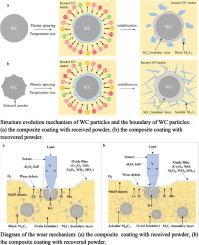粉末循环对等离子喷涂 Ni625-WC 复合涂层微观结构演变和磨损机理的影响
IF 5.3
2区 材料科学
Q1 MATERIALS SCIENCE, COATINGS & FILMS
引用次数: 0
摘要
在制备等离子喷涂涂层的过程中,金属粉末的利用率通常低于 70%,这引起了人们对效率的极大关注。研究了等离子喷涂 Ni625-WC 复合涂层中接收粉末(C-p1)和回收粉末(C-p2)的微观结构演变和磨损机理,以探讨粉末回收的可行性。结果表明,C-p2 中 WC 颗粒的边界层比 C-p1 厚 2.84 μm。脱碳的 WC 产物在 C-p1 中的 WC 颗粒边界和 Inconel 625 基体内分散成核,形成块 M23C6。相比之下,块状 M23C6 在初始加热后的接触面积更大,促进了 C-p2 中针状 M23C6 的成核和生长。此外,C-p2 的磨损率比 C-p1 低 9.1%。虽然 C-p1 较高的弹性模量(E)使 Inconel 625 基体与 WC 颗粒的粘附力更强,导致 C-p2 的粘附磨损程度更高,而不是剥离和粘附力降低,但 C-p2 中存在硬度更高、分布更均匀的针状 M23C6,且显微硬度(H)/E 比值更高,从而提高了耐磨性。本文章由计算机程序翻译,如有差异,请以英文原文为准。

Effect of powders recycling on microstructure evolution and wear mechanism of plasma sprayed Ni625-WC composite coating
The utilization rate of metal powders during the preparation of plasma-sprayed coatings is typically below 70 %, which has raised significant concerns regarding efficiency. The microstructure evolution and wear mechanism of plasma-sprayed Ni625-WC composite coatings with received powders (C-p1) and recovered powders (C-p2) were studied to investigate the feasibility of powder recycling. The results showed that the boundary layer at WC particles in C-p2 was 2.84 μm thicker than that in C-p1. Decarburized WC products were dispersed nucleation to form block M23C6 at the boundary of WC particles and within Inconel 625 matrix in C-p1. In contrast, the larger contact area of block M23C6 after initial heating promoted the nucleation and growth of acicular M23C6 in C-p2. In addition, the wear rate of C-p2 is 9.1 % lower than that of C-p1. Although the higher elastic modulus (E) of C-p1 caused the Inconel 625 matrix to adhere more strongly to WC particles, resulting in higher degree adhesive wear rather than exfoliations and less adhesion in C-p2, the presence of harder and more uniformly distributed acicular M23C6, and higher microhardness (H)/E ratio in C-p2, improved the wear resistance.
求助全文
通过发布文献求助,成功后即可免费获取论文全文。
去求助
来源期刊

Surface & Coatings Technology
工程技术-材料科学:膜
CiteScore
10.00
自引率
11.10%
发文量
921
审稿时长
19 days
期刊介绍:
Surface and Coatings Technology is an international archival journal publishing scientific papers on significant developments in surface and interface engineering to modify and improve the surface properties of materials for protection in demanding contact conditions or aggressive environments, or for enhanced functional performance. Contributions range from original scientific articles concerned with fundamental and applied aspects of research or direct applications of metallic, inorganic, organic and composite coatings, to invited reviews of current technology in specific areas. Papers submitted to this journal are expected to be in line with the following aspects in processes, and properties/performance:
A. Processes: Physical and chemical vapour deposition techniques, thermal and plasma spraying, surface modification by directed energy techniques such as ion, electron and laser beams, thermo-chemical treatment, wet chemical and electrochemical processes such as plating, sol-gel coating, anodization, plasma electrolytic oxidation, etc., but excluding painting.
B. Properties/performance: friction performance, wear resistance (e.g., abrasion, erosion, fretting, etc), corrosion and oxidation resistance, thermal protection, diffusion resistance, hydrophilicity/hydrophobicity, and properties relevant to smart materials behaviour and enhanced multifunctional performance for environmental, energy and medical applications, but excluding device aspects.
 求助内容:
求助内容: 应助结果提醒方式:
应助结果提醒方式:


